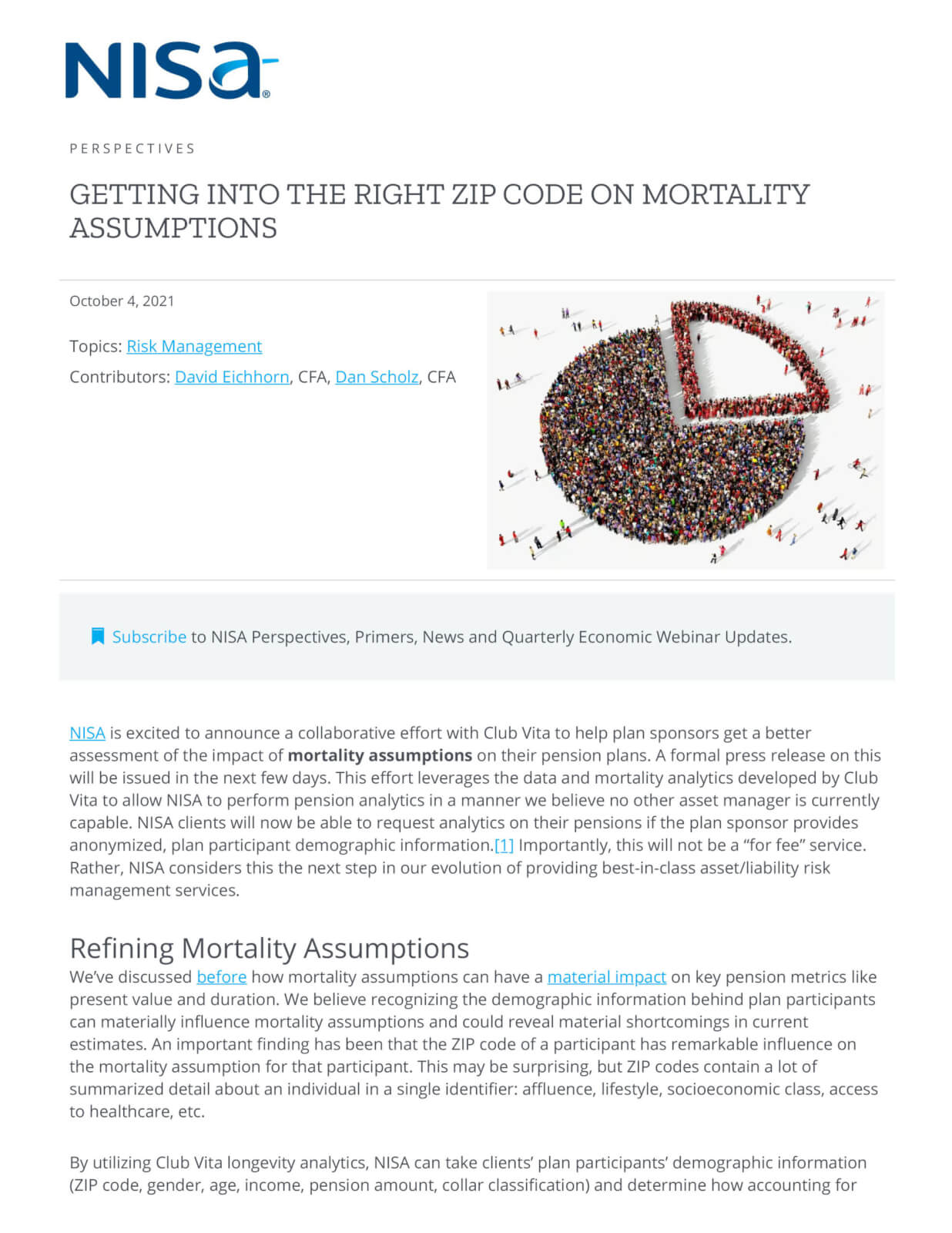NISA is excited to announce a collaborative effort with Club Vita to help plan sponsors get a better assessment of the impact of mortality assumptions on their pension plans. A formal press release on this will be issued in the next few days. This effort leverages the data and mortality analytics developed by Club Vita to allow NISA to perform pension analytics in a manner we believe no other asset manager is currently capable. NISA clients will now be able to request analytics on their pensions if the plan sponsor provides anonymized, plan participant demographic information.[1] Importantly, this will not be a “for fee” service. Rather, NISA considers this the next step in our evolution of providing best-in-class asset/liability risk management services.
Refining Mortality Assumptions
We’ve discussed before how mortality assumptions can have a material impact on key pension metrics like present value and duration. We believe recognizing the demographic information behind plan participants can materially influence mortality assumptions and could reveal material shortcomings in current estimates. An important finding has been that the ZIP code of a participant has remarkable influence on the mortality assumption for that participant. This may be surprising, but ZIP codes contain a lot of summarized detail about an individual in a single identifier: affluence, lifestyle, socioeconomic class, access to healthcare, etc.
By utilizing Club Vita longevity analytics, NISA can take clients’ plan participants’ demographic information (ZIP code, gender, age, income, pension amount, collar classification) and determine how accounting for this demographic information may impact pension plan metrics. To be sure, NISA is not an actuary and does not provide actuarial services. Any material findings from NISA-provided analytics that could impact decision making should be reviewed by the plan actuary.
Who Can Benefit The Most?
Investigating how demographic information may impact mortality assumptions may be particularly valuable for any of the following reasons:
| Plan Circumstance | Potential Impact of Analysis |
| Considering An Annuity Buyout | This might be the area where an analysis is most impactful. Insurance companies will utilize proprietary mortality models when making an offer on buyout pricing. Plan actuarial assumptions – typically used for financial and regulatory reporting purposes – are not designed to be reflective of insurance market pricing. Reducing any information asymmetry in how insurance companies may be valuing the pension liability could better indicate the genuine economics of a buyout transaction. |
| Lump-sum Offering/Small Balance Transaction | Plans considering a lump-sum offering may wish to drilldown on the impact of the demographic subset that will elect the lump sum. Particularly, low balance lump-sum offerings may be concentrated on lower socioeconomic demographics and the impact this has on the value of the liability for both the participants electing the lump sum and those that will remain after the offering may be of economic interest to the sponsor. We believe a similar bias may exist in small balance annuity transactions. |
| Hibernating Plans | Plans that are in or near their end state may wish to inspect the accuracy of their pension metrics. Increased or reduced longevity could impact the duration and pension valuation measures (i.e., funded status). Slippage in these measures can be a more significant contributor to risk in end-state portfolios than when material allocations to return seeking assets are present and overwhelm other risk factors. |
| Unique Demographics | Plans that have reason to believe their participant base may have unique demographic features that standard actuarial tables do not adequately represent could be interested in having analytics performed to see if this is the case. Concern over under- or over-estimating the liability could be impacting long-term planning. |
| Evaluating A Longevity Hedge | Plans that are interested in exploring longevity hedges will want to have a pension benefit projection that is closely aligned with insurance industry estimates to better evaluate the economic attractiveness of a hedge. |
| Curious Plans | Additionally, those just curious to see how demographically focused mortality estimates compare to those currently being used may be interested in having analysis performed. |
If You Are Interested
Please contact a client service representative if you would be interested in having NISA perform an analysis and we can discuss data needs and the analysis timeline as we ramp up this service.
About Club Vita
Club Vita is a longevity data analytics company, which facilitates the pooling and statistical analysis of demographic data from defined benefit (DB) pension and retiree health plans to reveal insights that would not be evident to the plans acting alone. Its first two clubs in the UK and Canada have served the needs of plan sponsors and their advisors since 2008 and 2015 respectively, with datasets now covering 1 in 4 of all retirees in receipt of DB pensions in the UK and Canada. Since establishing its US club in 2019, Club Vita has built a data set tracking the varied survival patterns in over 1m US retirees. Club Vita’s innovative team has designed, built and refined ZIP code based multi-factor socioeconomic models for understanding the diversity of longevity, enabling plan sponsors to tailor their assumptions to the specific characteristics of their plan’s participants and to develop strategies to actively manage their longevity risk. For more information, please visit their website.
[1] This demographic information is intended to connect plan participants to ZIP code and does not include Personal Identifiable Information (PII).




